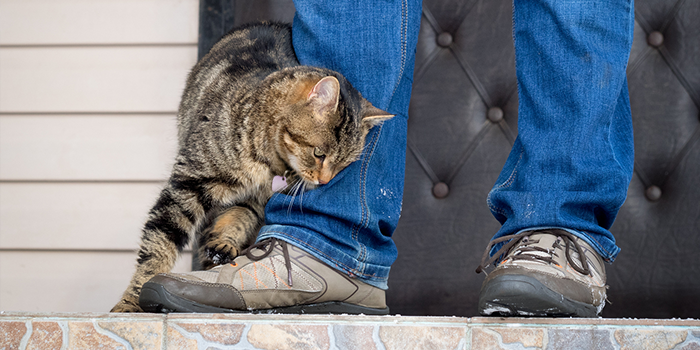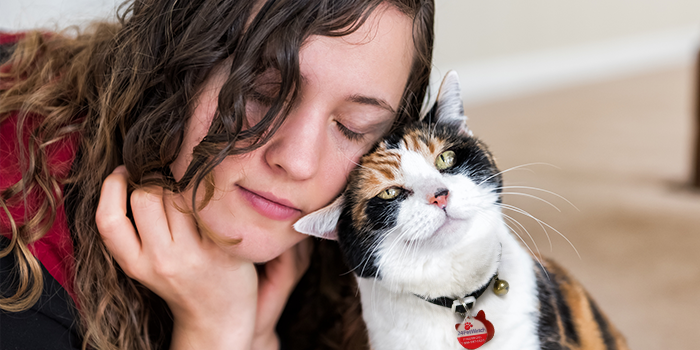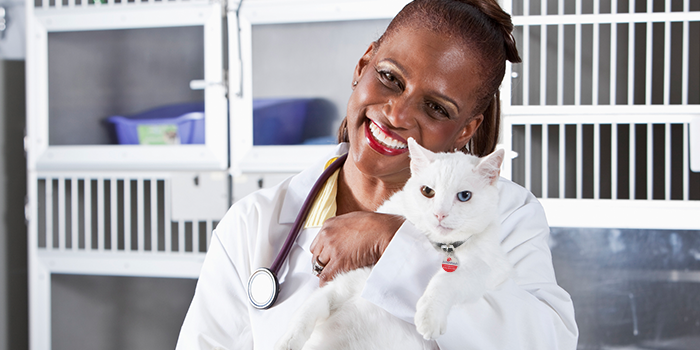What Does It Mean When a Cat Purrs?
By Sarah J. Wooten
Most cats engage in purring behaviour throughout their whole lives. But what exactly is the function of this vocalization, and what are cats trying to say to us when they purr? While most people think that a purring cat is a happy cat, it turns out that cats use purrs to signify a variety of emotional states, not just happiness. There’s even some evidence that cats may even heal themselves with purring. If you want to find out more about what your cat is communicating, keep reading. This article details everything we currently know about the cat purr and how to understand purring behaviour in your cat.
How Do Cats Purr?
All breeds of domestic cats purr, and several species of wild cats -- including bobcats, ocelots, and mountain lions -- purr as well. Big cats that roar, like lions, tigers, and jaguars, don’t purr. Cheetahs are the lone exception to this rule, in that they are big cats that can also purr. While we don’t exactly know why this is, one hypothesis by Dr. Benjamin Hart from UC Davis School of Veterinary Medicine suggests that roaring big cats lack the flexibility in their voice box required to produce the purr.
Purring is not limited to cats. Near relatives of the cat -- including genet, civets, and mongooses -- can purr. Guinea pigs, raccoons, and hyenas can also purr. While the sound of a purr originates from the muscles of the voice box, the purr itself begins in the brain. A stimulus, such as the gentle stroke of a human hand, triggers the brain to send signals to the laryngeal muscles, causing them to vibrate. As an animal breathes in and out, air streams through the vibrating laryngeal muscles, which causes the vocal cords to vibrate and creates the sound and feeling of a purr.

Purring: Why Do Cats Do It?
Cats learn how to purr when they are only a couple of days old. While we aren’t entirely sure why, it would make sense for kittens to use purring as an important form of communication with their mother, especially before their eyes open.
While the concept of a happy, purring cat is well known, cats purr for many reasons. A cat can purr in response to happiness, as a coping mechanism for stress, to solicit food or attention, and to communicate to other cats. A cat that is near death may purr. A cat that is purring at a veterinary hospital may be very stressed and scared and could be purring to self-soothe or to communicate appeasement. If you think about it, humans smile when they are happy, they can also smile to please other people when they are scared or nervous; we suspect that cats use purrs in the same way.
Cats purr when they are in contact with each other, with humans, and with desirable objects. They also purr when they are bunting (marking objects with the scent gland on their face by rubbing their chin), rolling, or kneading.
It is also suggested that cats purr to make their humans happy and healthy. Scientific American reported that a cat’s purr can reduce blood pressure and stress levels in humans, and that the frequency of a cat's purr -- between 25 and 150 hertz -- can facilitate bone density and healing. There is an old saying in veterinary medicine that “If you put a cat and a bunch of broken bones in the same room, the bones will heal.” It could be that purring facilitates healing, which would help explain why sick cats expend valuable energy to purr.
Cats use purring, in conjunction with other vocalizations and body language, to communicate with each other. They may also meow, chirp, or make a trilling sound when they greet each other. Though most meowing in cats is used to get humans to give them something they want, either food, opening a door, play, or physical attention.

How To Interpret Your Cat’s Purrs
How do you know what your purring cat wants or needs? The following are some of the more common purr patterns heard in cats and what they likely mean.
Happy-Purr: This is the classic purr. A cat that is purring from happiness will look relaxed, with half-closed dreamy eyes, and seem not to have a care in the world. They are usually cuddled up and cozy, either by themself, with a furry friend or with you, just vibin’. They might be kneading their paws. This is called a non-solicitation purr.
Meow-Purr: Cats can also add layers to their purrs to communicate different things. A cat that purrs and meows at the same time may be actively trying to get your attention for some reason -- usually for food. Cats that are engaging in this type of communication usually act expectant and demanding and may head butt you or actively rub their body on you. They may also actively glance toward what it is that they want -- food from the fridge, a snack from the cupboard. If you get up and move in the direction of what they want, the meow-purrs may get more frequent and insistent because our feline captors know how to train us well. This is called a solicitation purr, because the cat wants something.
I’m-Hurt-or-Scared-Purr: Cats that are in pain, are very sick, or very afraid may be trying to self-soothe or heal themselves with a purr. Cats who are purring to help themselves feel better will look sick or very scared (more about this in the next section). If a cat is purring while sleeping, then it could be that the cat is trying to repair themselves with a purr.

When To Take Purring More Seriously
Purring doesn’t always mean your cat is happy and well. If your cat is purring during a veterinary visit and is acting scared (frozen and doesn’t want to move, hiding, dilated pupils, swishing tail) then your cat is stressed and needs help from you or the veterinary professionals to reduce fear and anxiety during the visit. Other warning signs to look for in purring cats:
- Loss of appetite or energy level
- Acting tired or weak
- Acting spaced out, not responding to name
- Weight loss
- Hiding more or not interacting with the family
- Feels warm (fever)
- Limping or open wounds
- Vomiting and/or diarrhea
- Urinating or defecating outside the litterbox
- Drinking more water than usual
All of these are non-specific signs of illness in a cat that could be caused by any number of disorders or diseases. If you notice any of these signs, don’t disregard them simply because your cat is purring. Make an appointment with your local veterinarian as soon as possible to get your cat checked out.
Dr. Sarah Wooten is a small animal veterinarian and certified veterinary journalist.